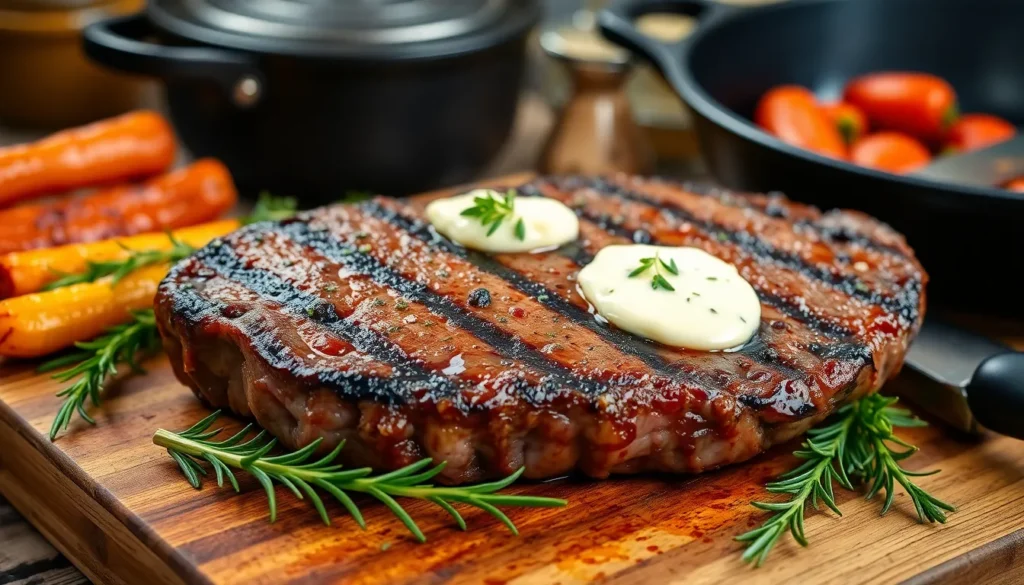We’ve discovered one of the most underrated cuts of beef that deserves a spot on your dinner table. Hanger steak – also known as “butcher’s steak” – was traditionally kept by butchers for themselves because they knew this hidden gem delivers incredible flavor at an affordable price. This tender cut hangs from the diaphragm and packs more beefy taste than many premium steaks.
What makes hanger steak special is its perfect balance of tenderness and robust flavor. Unlike expensive ribeyes or filets, this cut won’t expensive while still providing that satisfying steak experience you’re craving. The key is understanding its unique grain structure and cooking it properly to unlock its full potential.
We’ll show you how to transform this humble cut into a restaurant-quality meal that’ll have your family asking for seconds. With the right technique, hanger steak becomes incredibly juicy and flavorful – proving that the best steaks aren’t always the most expensive ones.
What Is Hanger Steak
Hanger steak gets its distinctive name from where it hangs inside the cow between the plate and the loin sections. We call this unique cut the “hanging tender” because it literally dangles from the diaphragm muscle without touching any bones. This positioning creates a naturally tender piece of meat that develops incredible flavor through minimal use during the animal’s lifetime.
The cut weighs approximately 1 to 1.5 pounds per whole piece and features a characteristic V-shape with a tough membrane running down the center. Butchers typically remove this membrane and divide the steak into two separate portions before selling. Each portion displays beautiful marbling throughout the deep red meat with a slightly coarse grain structure.
French cuisine celebrates this cut as “onglet” while bistros across Europe feature it prominently on their menus. American butchers have historically kept hanger steaks for themselves due to the limited quantity available from each animal. Only one hanger steak exists per cow which makes this cut relatively rare compared to other popular steaks.
The flavor profile delivers an intense beefy taste that surpasses many premium cuts. We describe the texture as similar to flank steak but significantly more tender when prepared correctly. The natural marbling provides richness while the muscle fibers create a satisfying chew that meat lovers appreciate.
Understanding this cut helps us maximize its potential in the kitchen. The key lies in recognizing that hanger steak responds beautifully to high heat cooking methods and benefits from proper grain cutting techniques during serving.
Ingredients
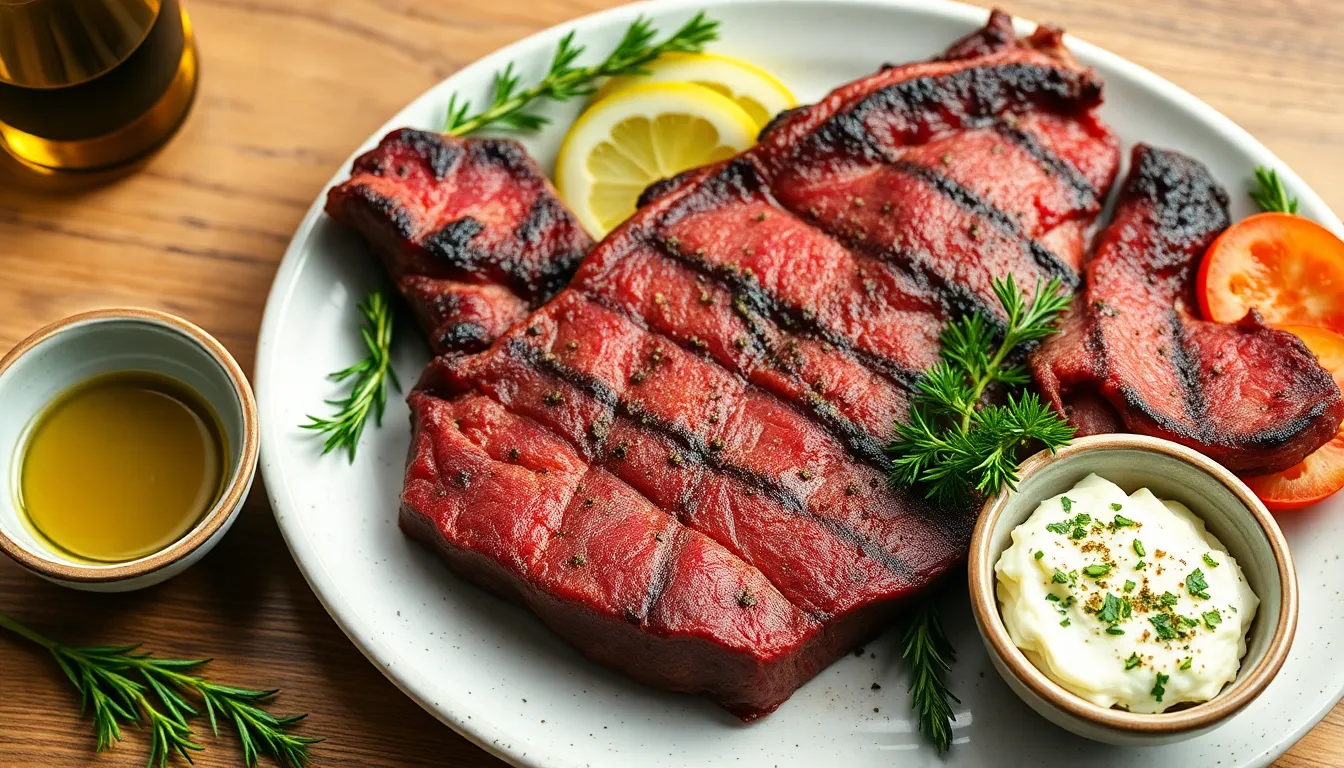
We’ve carefully selected ingredients that complement the hanger steak’s natural flavor while keeping preparation simple. Our ingredient list includes everything needed for the steak, marinade, and optional herb butter to create a restaurant-quality meal.
For the Steak
- 2 to 3 pounds hanger steak (usually 2 large steaks)
- Salt and freshly ground black pepper to taste
- Optional: trimmed silver skin on steaks removed
For the Marinade
- 1/4 cup olive oil
- 1/4 cup soy sauce (or Worcestershire sauce as variation)
- 2 cloves garlic, minced
- 1 tablespoon Worcestershire sauce
- Optional variations: 2 teaspoons oregano, 2 teaspoons cumin, 1 teaspoon paprika for spice rub
For the Herb Butter
- Butter softened (amount varies per serving)
- Fresh herbs like rosemary, thyme, or parsley, finely chopped
- Garlic, minced (optional)
Equipment Needed
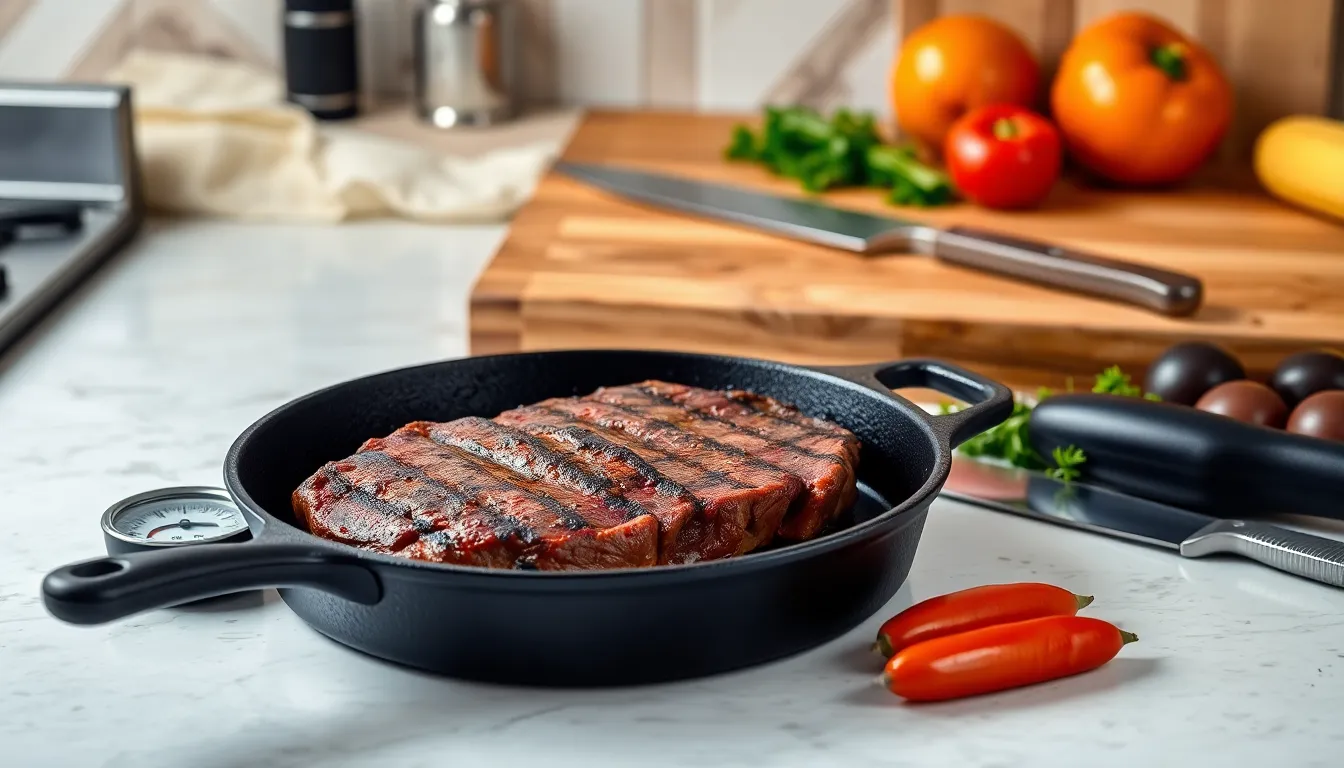
Preparing perfect hanger steak requires basic equipment that most home cooks already have in their kitchens. We recommend having the right tools ready before starting to ensure smooth cooking and optimal results.
Essential Cooking Equipment:
- Cast iron skillet or heavy-bottomed pan for stovetop cooking
- Outdoor grill for traditional grilling method
- Tongs or long-handled spatula for safe steak handling
- Meat thermometer for precise temperature monitoring
Preparation Tools:
- Large mixing bowl for creating marinades
- Sharp chef’s knife for trimming and slicing
- Cutting board (preferably wood or bamboo)
- Measuring cups and spoons for accurate ingredient portions
Serving and Storage Items:
- Large serving platter or individual plates
- Zip-top bags or shallow dish for marinating
- Paper towels for patting steaks dry
- Small bowl for mixing herb butter (if using)
The cast iron skillet stands out as our preferred stovetop option because it retains heat exceptionally well and creates beautiful searing. Your grill should reach high temperatures for proper caramelization of the steak’s exterior. A reliable meat thermometer ensures we achieve the perfect internal temperature of 135°F for medium-rare doneness.
Sharp knives become crucial for slicing the cooked steak against the grain, which maximizes tenderness. We suggest having all equipment clean and within easy reach before beginning the cooking process. This preparation approach allows us to focus entirely on timing and technique once the steak hits the heat.
Prep Instructions
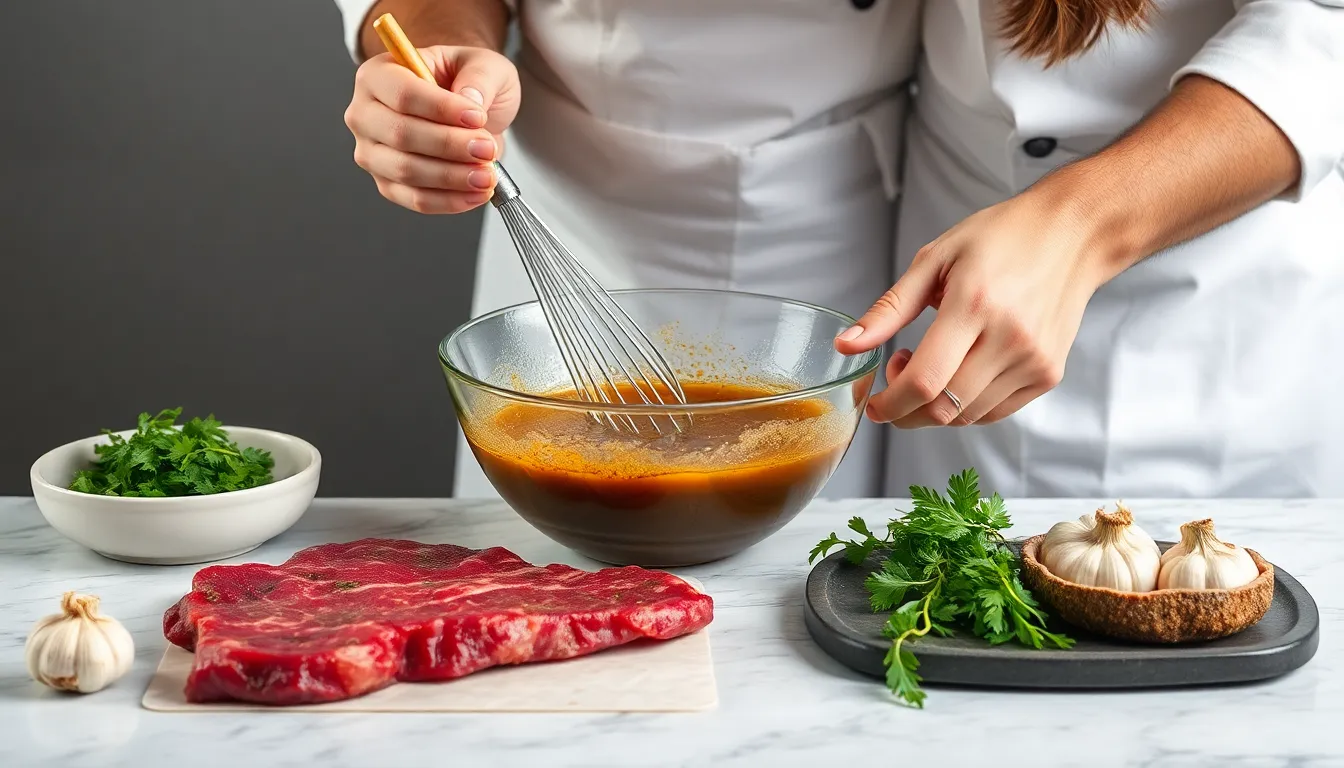
Proper preparation sets the foundation for our perfectly cooked hanger steak. We’ll walk through each essential step to maximize flavor and achieve restaurant-quality results.
Preparing the Marinade
We start by whisking together our marinade ingredients in a large mixing bowl. Combine 1/4 cup olive oil with 1/4 cup soy sauce or balsamic vinegar for the base. Add 2 cloves of minced garlic and 1 tablespoon Worcestershire sauce or Dijon mustard to build complexity. Season with 1/2 teaspoon salt and freshly ground black pepper to taste.
Optional herbs like rosemary or thyme can elevate the marinade’s flavor profile. We whisk all ingredients until well combined, creating a balanced blend of savory, tangy, and herbal notes that complement the hanger steak’s rich beef flavor.
Marinating the Steak
We place our trimmed hanger steak in a shallow baking dish or large bowl. Pour the prepared marinade over the steak, ensuring complete coverage on all surfaces. Cover the dish and refrigerate for at least 10 minutes, though overnight marinating delivers deeper flavor infusion.
Remove the steak from refrigeration about one hour before cooking to bring it to room temperature. We discard excess marinade and pat the steak completely dry with paper towels. This crucial step helps create the perfect sear during cooking.
Making the Herb Butter
We begin by softening 1/2 cup unsalted butter at room temperature until easily spreadable. Finely chop fresh herbs such as parsley, thyme, and rosemary, using about 1 tablespoon of each for optimal flavor balance.
Mix the chopped herbs into the softened butter along with a pinch of salt. Add minced garlic if desired for extra depth. We transfer the herb butter mixture to parchment paper, roll it into a log shape, and chill until firm. This herb butter will melt beautifully over our finished steak, adding richness and fresh herbal notes to enhance the eating experience.
Cooking Instructions
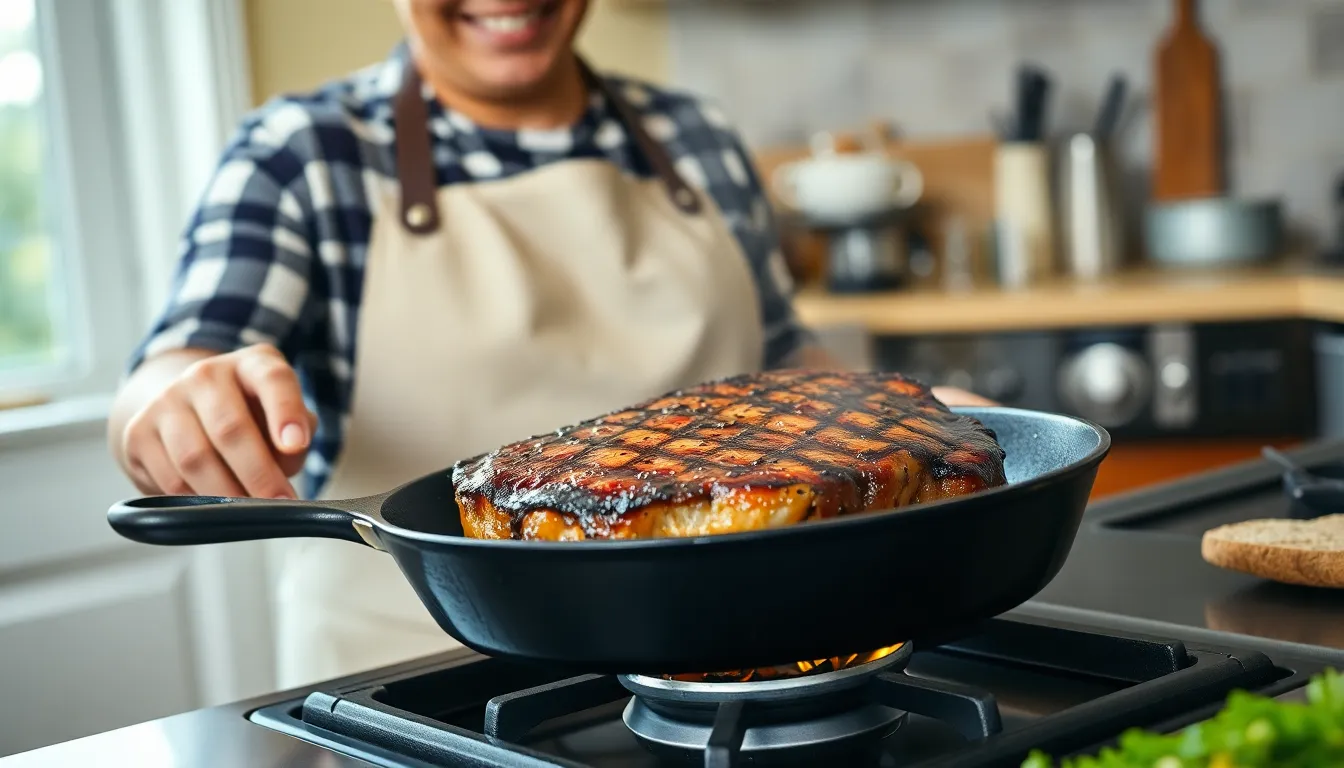
Now that our hanger steak has marinated and reached room temperature, we can focus on the cooking process. Proper technique during this stage transforms our affordable cut into a restaurant-quality masterpiece.
Preparing the Grill or Pan
We need to achieve high heat for an exceptional sear on our hanger steak. Preheat your grill to high heat or place a heavy skillet (cast iron preferred) on the stovetop over medium-high heat. Allow the cooking surface to heat thoroughly for 5-7 minutes before adding the steak.
For skillet cooking, we add a small amount of clarified butter or oil just before placing the steak in the pan. The oil should shimmer but not smoke when the pan reaches optimal temperature. This preparation ensures our steak develops a beautiful crust while maintaining tenderness inside.
Cooking the Hanger Steak
Remove the marinated steak from the refrigerator and let excess marinade drip off before cooking. Place the hanger steak on the hot grill or skillet with confidence. We grill or sear for approximately 4 minutes per side to achieve medium-rare doneness.
The steak should sizzle immediately upon contact with the cooking surface. Avoid moving or flipping the meat too frequently as this prevents proper crust formation. For skillet cooking, we can transfer the pan to a preheated 400°F oven after searing for 5-10 minutes to ensure even cooking throughout.
Overcooking transforms this tender cut into a tough disappointment, so we focus on achieving medium-rare to medium doneness for optimal results.
Checking for Doneness
Temperature accuracy determines our success with hanger steak cooking. Use a meat thermometer to check internal temperature at the thickest part of the steak.
| Doneness Level | Temperature Range |
|---|---|
| Rare | 125°F to 130°F (52°C to 54°C) |
| Medium-rare | 135°F to 140°F (57°C to 60°C) |
| Medium | 145°F to 150°F (63°C to 66°C) |
We remove the steak from heat slightly before reaching our target temperature since internal temperature continues rising during the resting period. This technique prevents overcooking and ensures perfect doneness throughout the meat.
Resting and Slicing
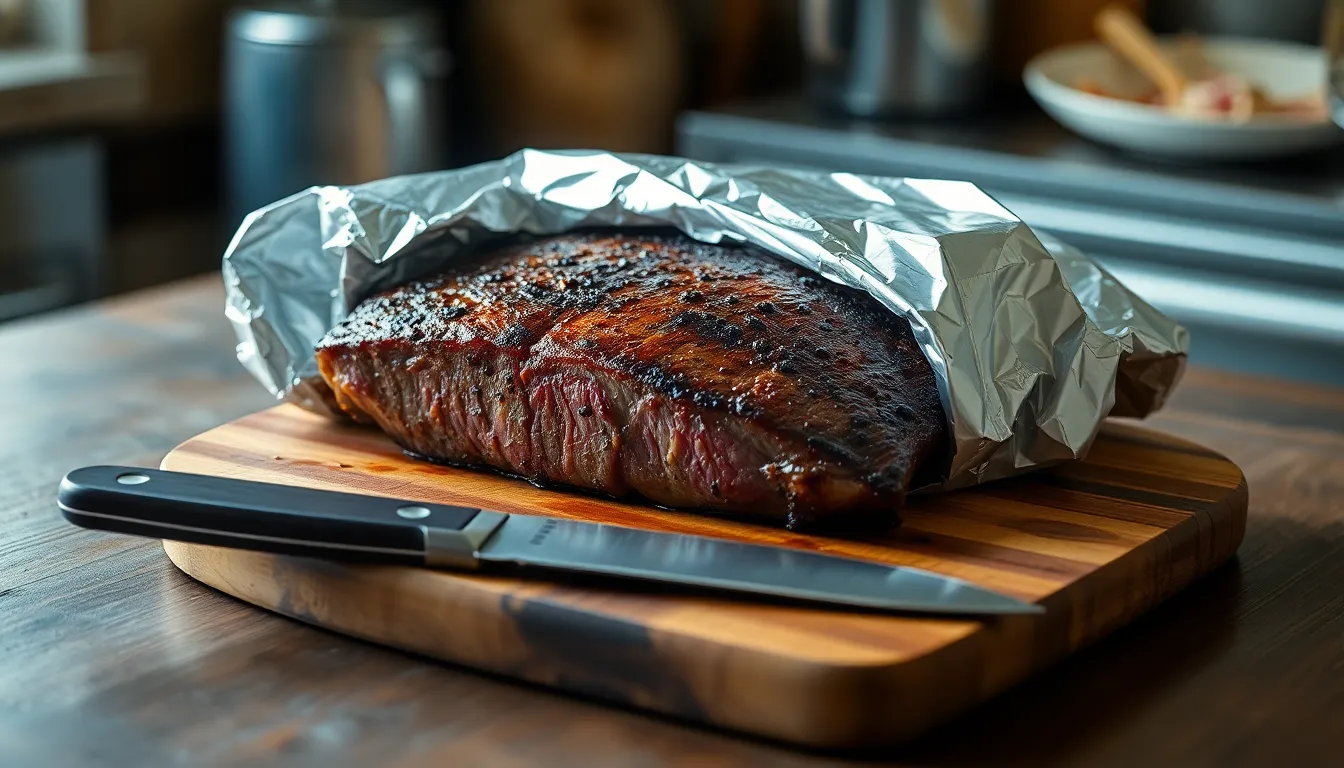
Once your beautifully seared hanger steak reaches the perfect internal temperature, the cooking process isn’t quite finished. The final steps of resting and slicing are crucial for achieving maximum tenderness and juiciness.
Proper Resting Technique
Resting your hanger steak for 10 minutes after cooking allows the juices to redistribute evenly throughout the meat. This redistribution process results in a significantly juicier and more flavorful steak that retains its moisture when sliced. We recommend transferring the steak to a cutting board and loosely wrapping it in foil to help retain warmth without steaming the meat.
During this resting period, the internal temperature will continue to rise slightly, ensuring the steak reaches its optimal doneness. Skipping this step will cause the juices to run out when you slice the steak, leaving you with a drier result. The waiting time is worth the patience as it transforms your hanger steak from good to exceptional.
How to Slice Against the Grain
Hanger steak features distinct muscle fibers running along its length, and identifying these fibers is key to achieving maximum tenderness. Look closely at the surface of your rested steak to determine the direction of the grain, which appears as lines running through the meat. Cutting perpendicular to these muscle fibers is essential for creating tender, easy-to-chew pieces.
Using a sharp knife, slice the steak into thin cuts approximately ¼ to ½ inch thick, maintaining a consistent angle throughout the slicing process. This technique shortens the muscle fibers in each bite, dramatically improving the eating experience and improving the steak’s natural tenderness. Proper slicing transforms even the most muscular cuts into incredibly tender portions that showcase the hanger steak’s robust flavor profile.
Serving Suggestions

After carefully resting and slicing our perfectly cooked hanger steak, we need to consider the best accompaniments to showcase its rich, beefy flavor. The right sides and beverages will complement the steak’s robust character while creating a memorable dining experience.
Side Dish Pairings
Grilled or roasted vegetables make excellent companions to hanger steak’s intense flavor profile. We recommend asparagus, bell peppers, or zucchini as they provide a fresh contrast to the rich meat without competing for attention. Their natural sweetness balances the savory elements of our marinated steak.
Creamy mashed potatoes or garlic roasted potatoes create the perfect foundation for our sliced hanger steak. The starchy comfort of potatoes absorbs the steak’s flavorful juices while providing a satisfying textural contrast. Garlic roasted varieties particularly complement the garlic notes in our marinade.
A fresh, crisp salad with vinaigrette offers a bright counterpoint to the meat’s richness. We suggest mixed greens with a simple lemon or balsamic vinaigrette that won’t overpower the steak’s natural flavors. The acidity helps cleanse the palate between bites.
Sautéed mushrooms or caramelized onions enhance the steak’s earthy, robust character. These umami-rich sides build upon the beef’s natural depth while adding aromatic complexity to each bite. They work particularly well when we use the pan drippings from cooking the steak.
Wine Recommendations
Medium to full-bodied red wines provide the ideal pairing for hanger steak’s bold flavor profile. We need wines with enough structure and tannins to stand up to the meat’s intensity without overwhelming its nuanced taste.
| Wine Variety | Flavor Profile | Why It Works |
|---|---|---|
| Cabernet Sauvignon | Full-bodied, dark fruit, firm tannins | Complements the beef’s richness |
| Malbec | Medium to full-bodied, plum, spice | Matches the steak’s robust character |
| Syrah/Shiraz | Bold, peppery, dark berries | Enhances the meat’s savory elements |
| Zinfandel | Fruit-forward, spicy, medium tannins | Balances the steak’s intensity |
These wine selections possess the necessary boldness to complement our hanger steak without overpowering its distinctive flavor. Each variety brings unique characteristics that enhance different aspects of the beef while maintaining perfect harmony on the palate.
Storage and Reheating
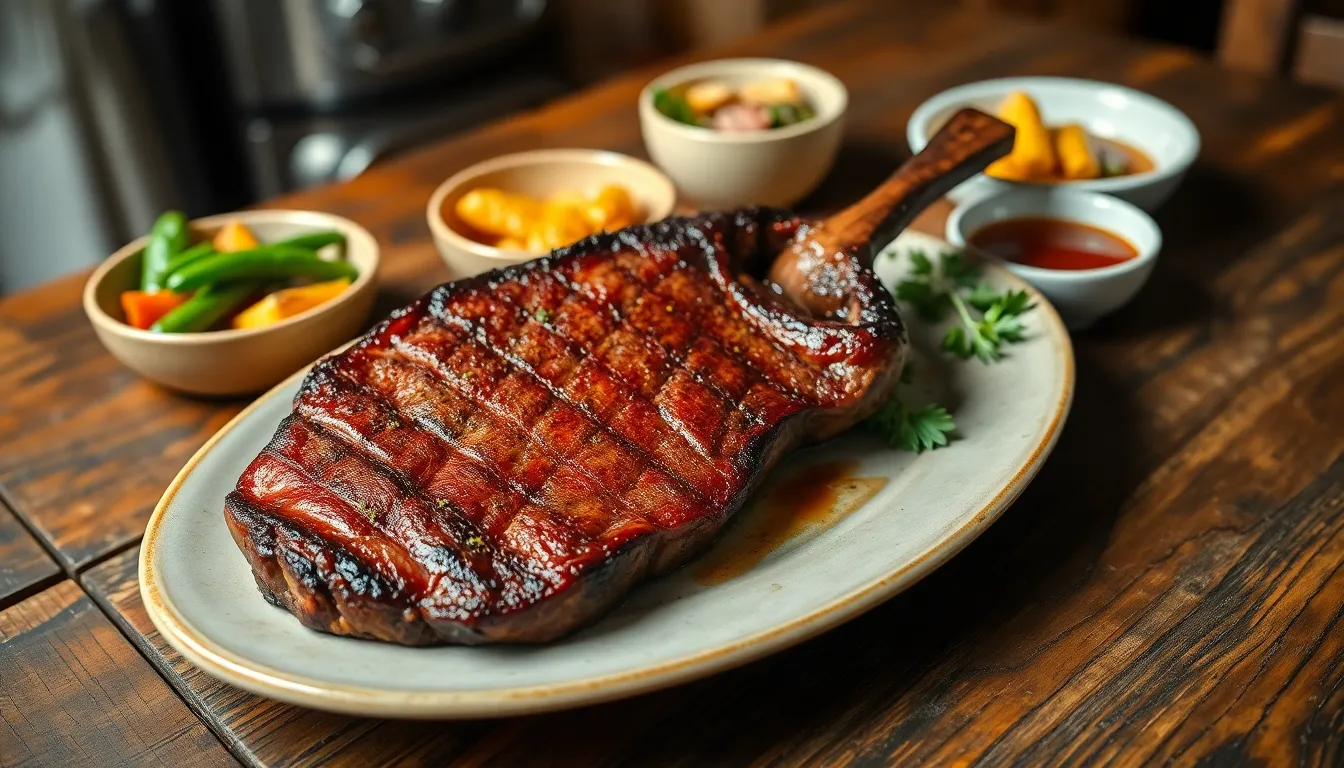
Proper storage and reheating techniques ensure our leftover hanger steak maintains its exceptional flavor and tender texture. Following these methods will help us preserve the quality we worked so hard to achieve during cooking.
Storing Leftovers
We should allow our cooked hanger steak to cool to room temperature before storing to prevent condensation and bacterial growth. Once cooled, we can store the steak in an airtight container or wrap it tightly in aluminum foil or plastic wrap to maintain freshness.
Our refrigerated hanger steak will stay fresh for up to 3-4 days when stored properly. For longer storage, we can freeze the steak by wrapping it well to prevent freezer burn, and it should ideally be consumed within 2-3 months for optimal quality.
Best Reheating Methods
We must reheat our hanger steak gently to avoid overcooking and drying out the meat. The key is using low, controlled heat that warms the steak without cooking it further.
Oven Method: We can place the steak in a preheated 250°F oven, covering it loosely with foil until warmed through. This method provides even, gentle heating that preserves the steak’s texture.
Stovetop Method: We heat a skillet over low heat with a bit of oil or butter, then warm the steak slowly on both sides. This technique allows us to control the temperature precisely while adding moisture.
Microwave Method: We use low power settings and heat in short bursts, checking frequently to avoid toughening the meat. This method requires careful attention but works well for quick reheating.
Adding a splash of beef broth or water during reheating helps maintain moisture and prevents the steak from drying out. We should avoid high heat reheating methods that cook the steak further, as this results in toughness and loss of that perfect texture we achieved initially. Resting the meat briefly after reheating allows the juices to redistribute, ensuring each bite remains as delicious as the original serving.
Tips for Perfect Hanger Steak

High heat remains absolutely essential for achieving restaurant-quality results with hanger steak. We recommend preheating your grill or cast iron skillet to the hottest setting possible, as this creates the caramelized crust that locks in juices and prevents overcooking. Our experience shows that maintaining consistent high temperature throughout the cooking process delivers the perfect balance of exterior searing and interior tenderness.
Temperature monitoring prevents disappointment every single time. We always use a reliable meat thermometer to check internal temperature, aiming for 135°F for medium-rare doneness. Hanger steak cooks remarkably quickly due to its structure, so checking temperature frequently ensures we never exceed our target doneness level.
Slicing technique dramatically impacts the final eating experience. We always identify the direction of muscle fibers before making our first cut, then slice perpendicular to those grain lines. This method maximizes tenderness and transforms what could be a chewy piece into fork-tender perfection.
Resting time cannot be skipped or shortened. After removing the steak from heat, we transfer it to a cutting board and let it rest for exactly 10 minutes. During this crucial period, juices redistribute throughout the meat, resulting in a significantly more flavorful and moist final product.
| Cooking Factor | Recommendation | Result |
|---|---|---|
| Heat Level | High temperature only | Caramelized crust, juicy interior |
| Internal Temperature | 135°F for medium-rare | Perfect doneness |
| Resting Time | 10 minutes minimum | Redistributed juices |
| Slicing Direction | Against the grain | Maximum tenderness |
Overcooking represents the most common mistake we encounter with hanger steak preparation. Since this cut contains less fat marbling than premium steaks, it becomes tough and dry when cooked beyond medium doneness. We monitor cooking time closely, typically allowing 4 minutes per side for optimal results.
Sauce pairings elevate the entire dish significantly. We frequently serve hanger steak with chimichurri, classic pan sauces, or our homemade herb butter to complement its rich beefy flavor. These accompaniments enhance rather than mask the natural taste that makes hanger steak so special among affordable cuts.
Room temperature starting point ensures even cooking throughout. We remove the steak from refrigeration 30 minutes before cooking, allowing it to reach room temperature naturally. This technique prevents the exterior from overcooking while the interior remains cold, delivering consistent doneness from edge to edge.
Conclusion
We’ve shown you that hanger steak doesn’t have to be the butcher’s best-kept secret anymore. With the right techniques and attention to detail you can transform this affordable cut into a restaurant-quality meal that rivals much more expensive options.
The key lies in understanding the fundamentals: proper marination high-heat cooking precise temperature control and most importantly proper resting and slicing techniques. These steps ensure you’ll unlock the full potential of this incredibly flavorful cut.
Now it’s time to put this knowledge into practice. Your next dinner party or weeknight meal just got a whole lot more impressive and your wallet will thank you for choosing this hidden gem over pricier alternatives.
Frequently Asked Questions
What is hanger steak and why is it called “butcher’s cut”?
Hanger steak is a flavorful, tender cut of beef located between the plate and loin sections of the cow. It’s called “butcher’s cut” because butchers often kept this exceptional piece for themselves due to its incredible taste and affordability. Only one hanger steak exists per cow, making it relatively rare and highly prized for its intense beefy flavor.
How long should I marinate hanger steak?
Marinate hanger steak for at least 10 minutes for basic flavor enhancement, but overnight marinating is recommended for deeper flavor infusion. The marinade should include olive oil, soy sauce or balsamic vinegar, minced garlic, and seasonings. Always bring the steak to room temperature and pat it dry before cooking for the best sear.
What’s the ideal cooking temperature for hanger steak?
Cook hanger steak to medium-rare at 135°F internal temperature for optimal tenderness and flavor. Use a meat thermometer for accuracy and cook approximately 4 minutes per side on high heat. Remove the steak slightly before reaching target temperature as it continues cooking while resting.
Why is it important to slice hanger steak against the grain?
Slicing against the grain is crucial for maximizing tenderness in hanger steak. Identify the direction of muscle fibers and cut perpendicular to them. This technique breaks down the muscle structure, making each bite more tender and easier to chew, enhancing the overall eating experience.
How long should hanger steak rest after cooking?
Rest hanger steak for 10 minutes after cooking to allow juices to redistribute throughout the meat. Transfer to a cutting board and loosely wrap in foil during this period. This resting time is essential for achieving maximum juiciness and flavor in every bite.
What are the best wine pairings for hanger steak?
Medium to full-bodied red wines pair excellently with hanger steak’s bold flavor. Recommended options include Cabernet Sauvignon, Malbec, Syrah/Shiraz, and Zinfandel. These wines complement the steak’s rich, beefy taste without overpowering it, creating a harmonious dining experience that enhances both the food and wine.
How should I store leftover hanger steak?
Store cooked hanger steak in an airtight container or tightly wrapped after cooling to room temperature. Refrigerated steak lasts 3-4 days, while freezing extends storage time significantly. For reheating, use gentle methods like low-temperature oven or stovetop to avoid overcooking and maintain tenderness.
What equipment do I need to cook hanger steak properly?
Essential equipment includes a cast iron skillet or heavy-bottomed pan for stovetop cooking, tongs or long-handled spatula, and a reliable meat thermometer. You’ll also need a sharp chef’s knife, cutting board, and mixing bowl for preparation. Cast iron is preferred for its excellent heat retention and searing capabilities.

